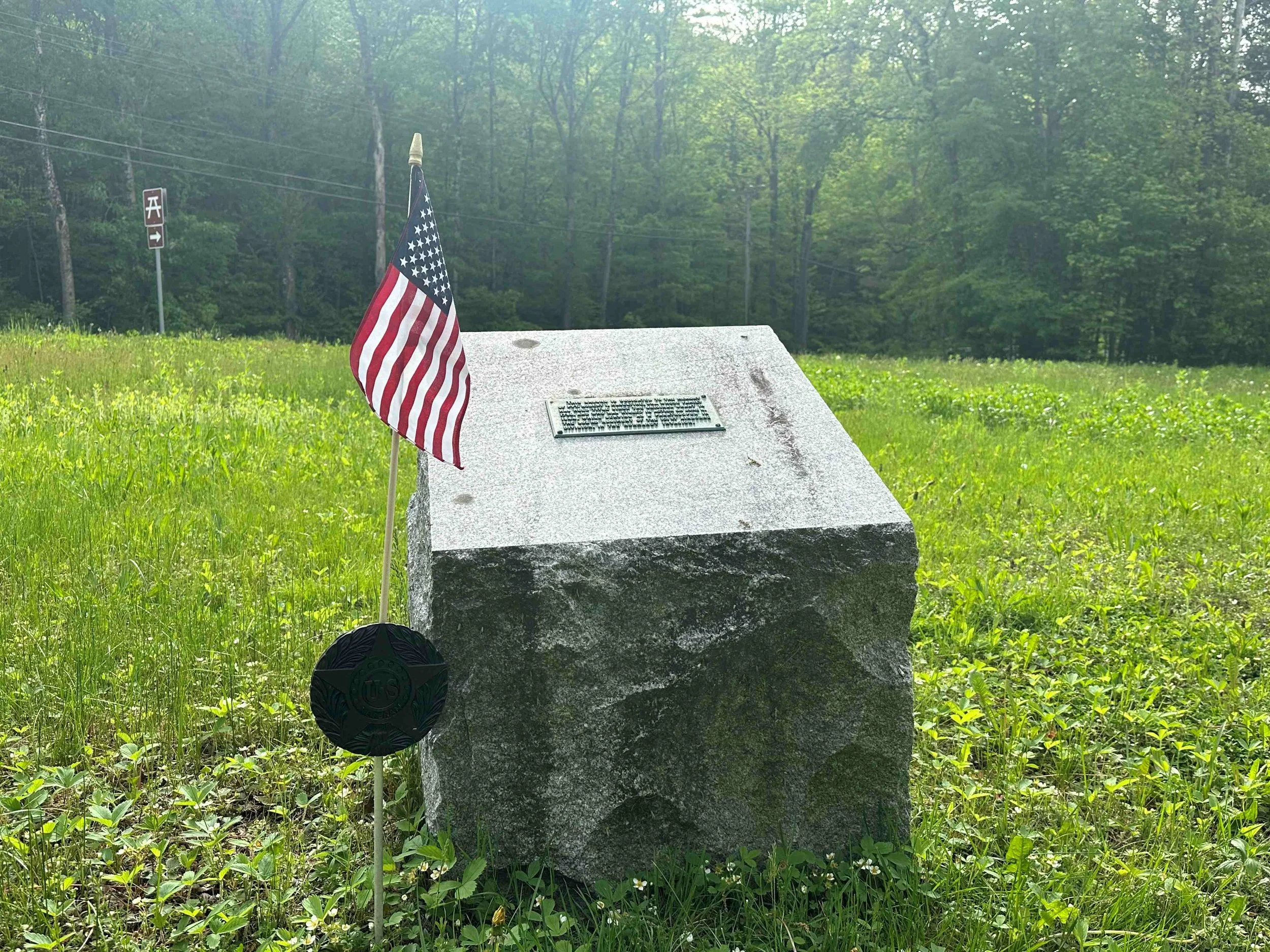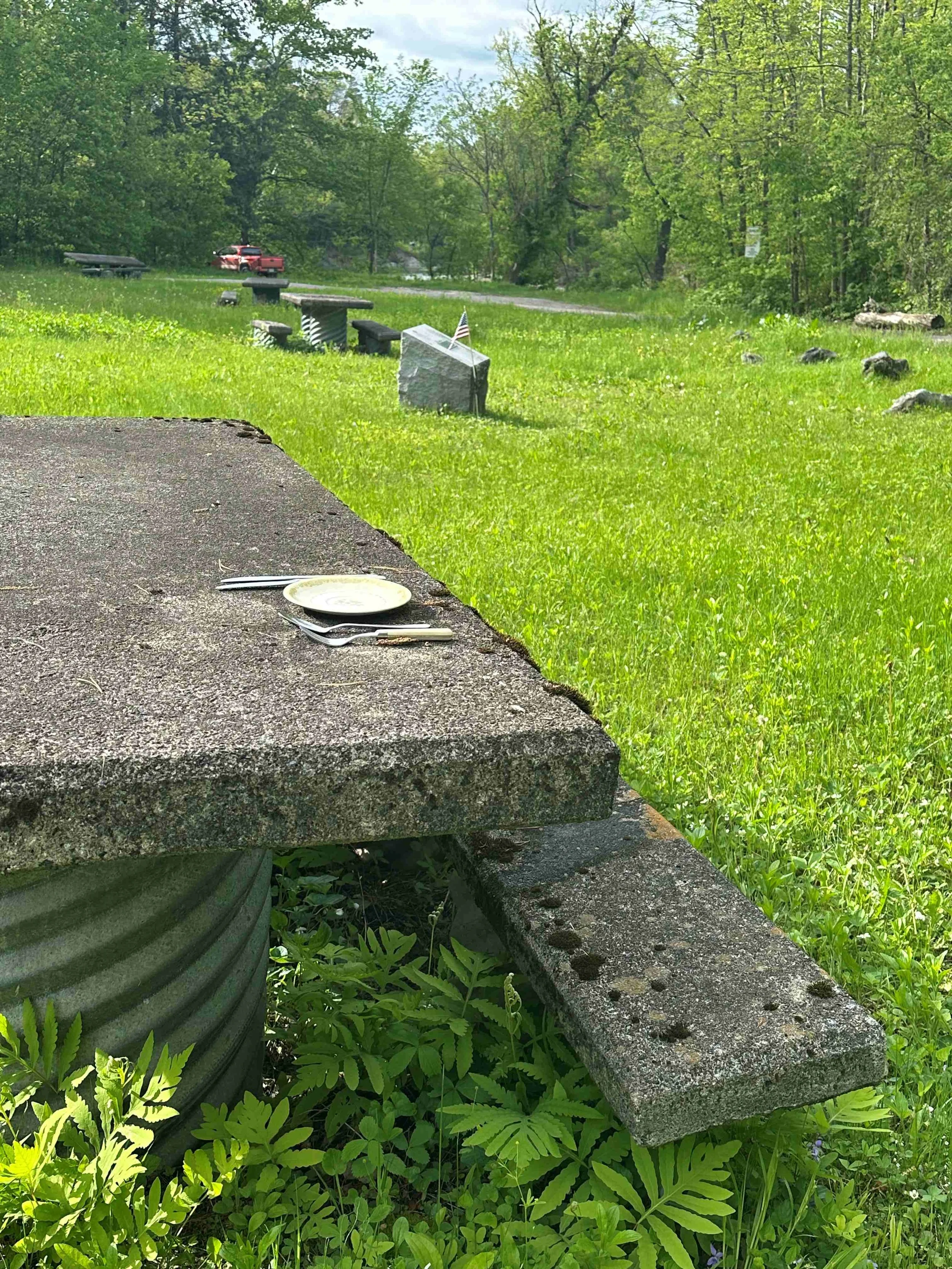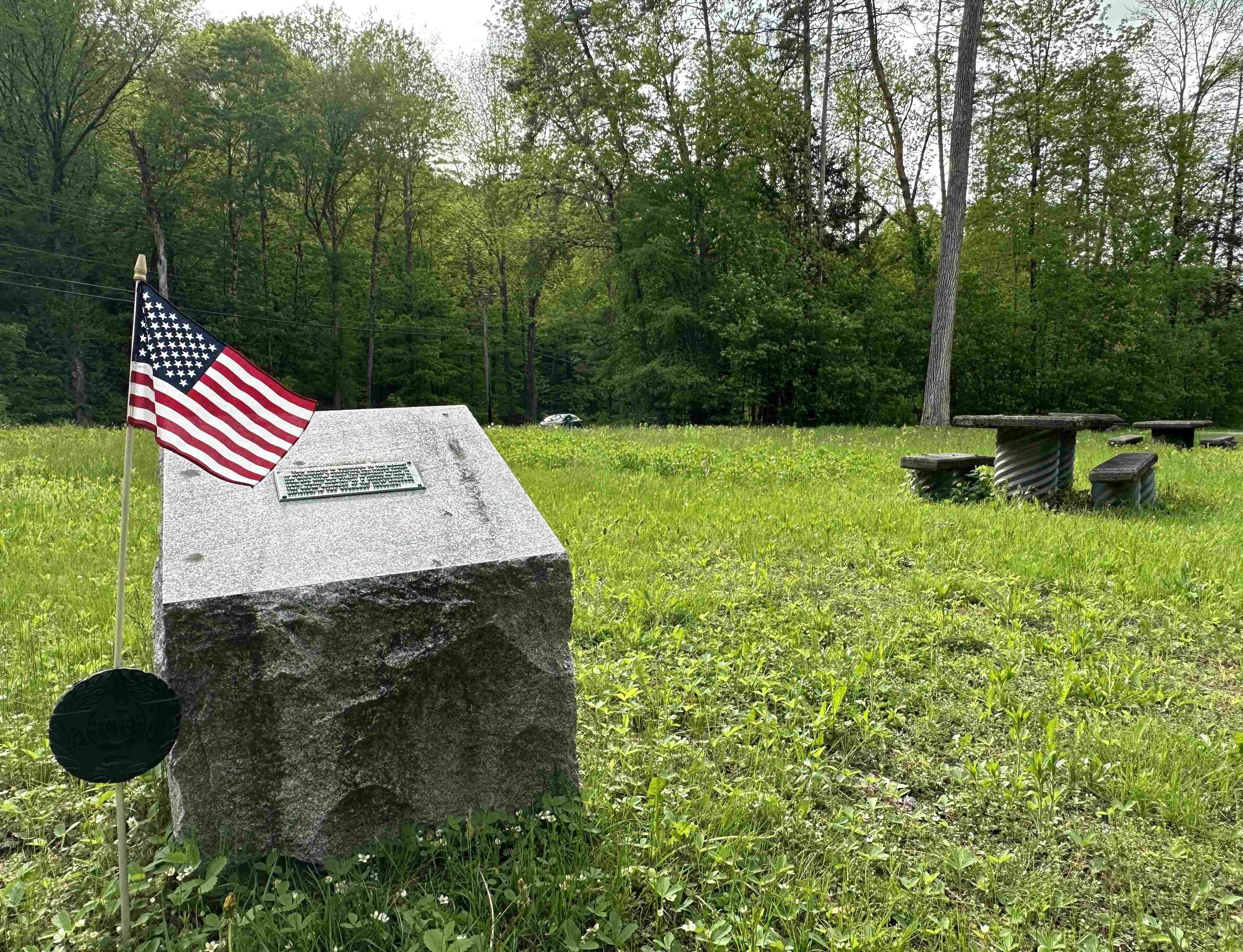Local paratrooper killed after D-Day landings 81 years ago
May 22, 2025 | By Brian LindnerPrivate Bob Haseltine. His overseas cap bears the regimental patch for the 502nd Parachute Infantry Regiment. This hat is in the Waterbury Historical Society collection.
At the annual meeting of the Fairmount Cemetery Association in May 1939, Bob Haseltine Jr. was appointed as the official caretaker. Far back in 1790, the King of England had granted a long, narrow stretch of land along the Winooski River in Moretown to Haseltine’s ancestors.
In today’s world, the King’s Grant location is the strip of land generally between U.S. Route 2 and the Winooski River extending south from about Snowfire to beyond Majestic Auto. Just south of the intersection of U.S. Route 2 and Vermont Route 100, on top of the slight rise next to Ted’s Kar Kare, is the tiny Fairmont Cemetery on what was once part of that King’s Grant. (Several spellings have been used over the years.)
Nine years after he became the cemetery’s caretaker, Haseltine was buried in the back row, marked every year by a flag placed by members of Waterbury’s American Legion Post #59. Private Haseltine was one of 10 men from his small Medical Detachment to be killed in action. He was a medic in the 101st Airborne Division, and the long line of Haseltines in America ended with his death.
Not far away, a generally overlooked monument stands in Haseltine’s honor in the Route 2 picnic-area turnoff about one mile south of Waterbury. For over eight decades, the American Legion has also placed a flag at that location to honor Haseltine’s sacrifice.
A great long-distance runner first
Waterbury High School track team with coach “Doc” Haseltine standing second from left in the back row. Young Haseltine is seated second from left in the second row. (Seated on the left, front row, is Theron Clough, who also served and died in WWII. Wounded and being evacuated, his ambulance was ambushed by Japanese forces who executed U.S. drivers and patients.)
Haseltine moved to Waterbury as a child because his father’s profession brought him to the town. Robert Ingersol “Doc” Haseltine, Sr., taught science at Waterbury High School (later at Dartmouth), but was never able to get his own son to be a very successful student.
Robert “Doc” Haseltine Sr., and Pvt. Robert Haseltine Jr. at home on leave. Behind them is U.S. Rt. 2, and a section of the Palisades ledges along the Winooski River.
Young Bob was much more interested in long-distance running, and in this endeavor, he excelled. Decades before it became fashionable, Haseltine was dedicated to running. The 1932 Championship trophy at Waterbury High School shows his name engraved along with his teammates. Years later, during the demanding training as a paratrooper, he routinely stunned and amazed his fellow soldiers by returning to the barracks after a day of grueling training, putting on sneakers, and going back out to run 15 miles.
Fellow airborne veteran Ed Zelonis recalled, “He was a great runner. Ten-mile runs were nothing for him while all the other guys had a tough time.”
Decades after the war, 101st Army veteran Carl Robare told of how Haseltine, while stationed in England before the D-Day invasion, would take off his army boots and replace them with an “old pair of white tennis shoes (the low-cut type)” and run off into the area around Deuford Manor in Hungerford, Berks County, in England. His fellow paratroopers called those sneakers his “ballet shoes.” Ray Smith said, “I used to run with him up to about the 8- or 10-mile marker, but he could easily run 25 mile[s].”
Haseltine’s sister, Marian Grace, told how he (after three years at Waterbury High School) had graduated from the Montpelier Seminary School and routinely ran to school and back from their home in Moretown.
From the Winooski’s Palisades to Normandy
Robert Ingersol Haseltine, Jr. was born on May 3, 1915, in Baltimore, Maryland. At age 29, he lost his life serving in one of America’s most famous military divisions in one of America’s most famous battles. Unlike other frontline soldiers from Waterbury who lost their lives, Haseltine entered combat with absolutely no weapon. He was a medic in the 3rd Squad, 1st Platoon, Company D, 502nd Parachute Infantry Regiment, of the 101st Airborne Division known as “The Screaming Eagles.” He was there to save lives, not take them.
The 502nd Medical Detachment’s medics, aides, and doctors during training. Haseltine sits on the far left.
In February 1942, he travelled to Fort Devens, Massachusetts, and enlisted in the U.S. Army, where he would undergo nearly two and a half years of training before parachuting in the D-Day landings in Normandy, France, and being killed two days later. The dozens of comments received about Haseltine during the course of this research can best be summarized by quoting from an article by Harry Cutting, a prominent local figure: “We were saddened last week by the report that Bob Haseltine has been killed in action. Many of you will remember him, happy-go-lucky, taking things as they came, with a cheery greeting and a joke for everybody.”
A young Robert Haseltine with his friend Desi Kervella from New Jersey on a dock in the Winooski River at the Palisades.
After moving to the King’s Grant land, Haseltine’s parents ran a collection of small tourist cabins at the Palisades. This is the section of the Winooski River just south of Waterbury, bounded by steep ledges. The cabin rentals helped to supplement Doc Haseltine’s income as a teacher at Waterbury High School. During the 1930s, the Kervella family of New Jersey made it a summer routine to stay in the cabins, and thus, Desi Kervella became close friends with Bob Haseltine when they were teenagers.
Kervella tells the story of how, one day in September 1930, 15-year-old Bob arbitrarily decided to skip school and showed up on her doorstep in New Jersey after a long hitchhike. (Meanwhile, back at home in Vermont, Haseltine had been missing for several days before Mr. Kervella sent a telegram to Haseltine Sr. advising that young Bob had arrived unannounced. While he was missing in Vermont, locals had searched for him, concentrating on the hills around the Palisades.)
At the Kervella home, Haseltine asked Desi’s father for a job, which was granted on the condition that he return to Vermont after one week. Haseltine worked the agreed-upon week, was paid for his labor, then given an extra $20 for his return hitchhike to Vermont. Bob did return home, and Mr. Kervella received his $20 back soon thereafter. Haseltine had carried it back in his shoe – just in case.
Haseltine just having completed a training jump.
A medic in the paratroopers
Haseltine after a jump with camera equipment.
In May 1942, Haseltine was a soldier in the U.S. Army’s famous 101st Airborne Division, and on the 29th of that month, he qualified to receive his parachute wings. As was typical for him, he carried a camera during one of his first jumps and took pictures as he drifted to the ground. On the back of one photo, he wrote, “It gives an idea how happy a feller is to get his feet on the ground again.”
Whereas most enlistees were hoping for combat and a chance to prove themselves and win medals, Haseltine joined the 502nd Medical Detachment of the 101st and began years of training as a combat medic. Within the unit, his medic skills were unmatched – he was a superior student to a degree that would have made his father very proud.
Carl Robare writes of one incident illustrating Haseltine’s skills. Robare and two friends were jumped by other (non-paratrooper) GIs who wanted to find out how tough the men of the 101st were. Robare wrote:
“Myself, and my two friends came back to camp, late that night, with 2 black eyes, (one on each of my friends) – and a badly cut lip (at the corner of the mouth) on me – We couldn’t very well go to the Medical Office, for repairs, so we awakened Bob Haseltine, out of a deep sleep, and explained to him, about all the paper work that would be involved, would he please, patch us up. Bob offered sympathy to the two black eyes, but he said he would try something new to me, that he had learned, at a training session. It was called the Butterfly Stitch, strips of adhesive tape crisscrossed over the wound pulling it together. He said, there wouldn’t be any scar, and believe me, it worked. I’m 72 years old, and there is not a scar showing. That’s the kind of Medic Robert Haseltine was.”
A wartime marriage
The young bride and groom, Robert and Alice Haseltine. She was extremely helpful on this project.
In August 1942, Haseltine had been one of the lucky few 101st men scheduled for a parachute jump on Martha’s Vineyard near Edgartown, Massachusetts. His wife describes how they met:
“That evening a dance was given for them at the tennis club in Edgartown and all the eligible young ladies were invited to attend...When I arrived it was a ladies cut in and I looked for a tall man. I cut in and it was Robert Haseltine. We spent most of the evening sitting upon the balcony railing talking.”
They corresponded but were unable to see each other again until the following April, when they went to see the Boston Marathon. (He had hoped to run but couldn’t due to a leg injury.) The next day, he proposed, and Alice Smith accepted! The following month, they were able to meet again in New York for sightseeing and to make wedding plans. Haseltine was able to obtain a three-day pass and they married on July 28, 1943.
In this honeymoon photo, newlyweds Robert and Alice (front) are seated in front of Robert’s father and three sisters, along with a niece and nephews. Note his running shoes.
After driving all night, they reached Vermont and the Haseltine home on the banks of the Winooski River. During the honeymoon, he wore his Army uniform, but with his running sneakers. This was only the 10th day they had been able to spend together since meeting the previous August. On the 12th day, they returned to New Haven, Connecticut, where he boarded a train.
In the 1990s, Alice wrote: “The last time I saw Robert was Sun 12 noon as he waved goodbye from the train.” (In September 1943, she received a call saying he would have a three-day leave in New York before going overseas.” She drove to New York to meet but, “All leaves were cancelled [and I] never saw him again.”
From their first meeting at the dance until he was killed in action, the couple had spent a total of only 12 days together. The war had doomed their romance.
The division moves to England to prepare for D-Day
In May 1944, Haseltine wrote from England to his new mother-in-law to thank her for a cake she had mailed. He added, “Only thing is that I’m purty lonely. Not much fun in seeing and doing things without Alice. Then – I think how lucky I am to have her to come home to.”
He continued to run, and run, and run during his time in England. This was still his primary recreation, and he participated in several races where he placed high in the field. He wrote his father that he had been in the English Marathon – perhaps a first for an American, according to his letter. He finished 20th in a field of 50.
In another letter, postmarked five days before D-Day, he wrote his sister saying he wanted to return home to begin building a new home for himself and his wife. He also wanted to “have a garden, cow, chickens and all that contribute to a good meal. [I’ve] had my fill of Army chow....” His final letter to his sister closed with, “Just can’t wait to get at ‘The Palisades’ with you & Pop and ‘MY WIFE.’”
Parachuting into combat
On the late afternoon or evening of June 5, 1944, Haseltine was among the 101st Airborne paratroopers who boarded C-47 airplanes at the Greenham Common Airfield before flying over the English Channel to attack the Nazi occupied coast of Normandy.
Their mission was to parachute near St. Mere Eglise, in the middle of the night, as the spearhead of the entire D-Day invasion. His parachute time was probably between midnight and 1 a.m. on June 6. Unfortunately, the 502nd regiment was mistakenly dropped deeper into enemy territory than planned, and this may have been a factor in his death.
For the next two days of combat, Haseltine was with other members of Company D. Paratrooper Carl Wheeler recalled, “He was with us from out of the plane until he stayed behind at a crossroad outside the little French village by the name of Turqueville.”
World War Two map showing Turqueville, France. The best evidence is that Haseltine was killed at one of the two crossroads shown just below the letter “T” in Turqueville. The “front lines” would have been behind them, probably in the area of Sebeville.
The front lines facing the 101st were a rather scrambled mess, and it was easy to get behind the enemy without realizing it. This may have happened in Haseltine’s case. An official 101st map shows the “front line” to be near Houesville. Turqueville was indeed behind the lines at this point in the invasion.
On June 8, Haseltine and his small patrol were scouting when they came upon one or two (the number is unclear) wounded GIs at a crossroads, on a dirt road just in front of the town. Haseltine volunteered to remain with the wounded men and care for them while the patrol proceeded ahead. The patrol leader said they would return shortly but would first check the town for German troops. Approximately one hour later, they returned to find Bob Haseltine and his patient(s) murdered.
Edd Nelson, who parachuted from the same plane as Haseltine, wrote he had been told shortly after D-Day (possibly by Pfc. Jay E. Powell) that Powell recalled Haseltine stopping at the crossroads to give aid to some of those who were wounded and never saw any of them alive again. They had been “killed by the enemy revenge-style,” Nelson wrote.
This area of Normandy was partially occupied by “Ost troops.” These were primarily Russians serving voluntarily in the German army as foreigners. German troops generally looked upon them with skepticism and disdain. Often these volunteers felt the need to be extra violent to show their German superiors that they were indeed dedicated to the Nazi cause.
Coupled with this was the widespread false belief by the Germans and their allies that paratroopers of the 101st had been formally ordered to never take prisoners.
It is likely these two factors converged when an enemy patrol found Haseltine and his patient(s). When Haseltine’s remains were found, he had a fractured jaw and a broken left arm – possible evidence of a beating prior to being shot. (Following the war, Ost troops captured by the Allies were shipped back to Russia, generally against their will, where Stalin had them executed.)
Haseltine’s body was recovered some distance from his patient(s) and buried the next day in the temporary Utah Red Cemetery just behind the D-Day beaches. On June 25, his remains were disinterred and reburied in the permanent St. Mere Eglise American cemetery. There he remained until April 22, 1948, when he was again disinterred, re-identified, and placed in a coffin to be returned to the Haseltine King’s Grant at the request of his young widow. His coffin left France on June 25, 1948. At this time, the Army documented that his remains were dressed in his jump uniform and still wearing his paratrooper boots. Haseltine was one of 3,734 Americans whose remains were brought home on this voyage by the U.S. Army transport ship Greenville Victory.
Fairmont Cemetery is tucked between homes and businesses along U.S. Route 2 in Moretown. Photo by Lisa Scagliotti
After D-Day, Haseltine’s wife and family heard nothing of him for about two months until his widow was finally advised of his death via telegram. In late September 1945, a memorial service was held in Waterbury. The entire congregation stood silent in memory of Haseltine and the other Waterbury men who had also lost their lives to that point in the war.
On Thursday, July 15, 1948, Haseltine’s remains were buried in the Fairmount Cemetery in Moretown with full military honors. The Haseltine family name ended with Bob’s death. Today, there is a monument, easily visible from Route 2 in the Palisades, in his memory, making Haseltine the only local soldier to be memorialized on an individual monument.
During the 1990s, the widowed Alice Haseltine (who had remarried), always maintained contact with Bob’s family and donated many items to the Waterbury Historical Society in her husband’s memory. His sisters added more to the collection. Now on display in the Waterbury History Center Museum at the town offices is an extremely rare 101st Airborne jump uniform he left behind. Also, along with these donations is a pair of Bob’s running shoes, donated by his nephew.
Headstone for Robert Haseltine Jr. in the Fairmont Cemetery in Moretown. Photo by Brian Lindner
The contents of a soldier’s pockets
Details from Haseltine’s Individual Deceased Personnel File show that the personal items in his pockets at the time of his death were exactly: two pencils, a pen, a picture case, a gold wedding ring, a wallet, two mirrors, a pair of scissors, two combs, pictures, 200 Francs and a Seamans Discharge document. The last item is a complete mystery, as Haseltine never served in a naval unit.
Finally, below are comments from interviews and letters from those who knew Pvt. Haseltine:
“He was “a wonderful boy and a great runner.” - Dascomb Rowe, Waterbury High School principal and running coach
“He was one of my very best friends.” - Ray Smith, 101st vet
“Bob was a soldier’s soldier wherever he was.” - Handsford Vest, 101st vet
“Can honestly say that he was the greatest person I ever met.” - Harvey Brotman, 101st vet
“He was a quiet man, loved to run, and everyone thought well of him.” - William Harvey, 101st vet
“It was a great loss because he was such a great guy.” - Louis Mete, 101st vet
“He was not only a good medic, he was also a good soldier, and a good friend.” - Carl Robare, 101st vet
Postscript: Remembering Pvt. Robert Haseltine today
In addition to Haseltine’s gravesite in Fairmont Cemetery in Moretown, a singular monument to Haseltine’s sacrifice and his family’s role as early local settlers dating back to colonial times rests between stone picnic tables in a small, unnamed park along U.S. Route 2 near the Winooski River in Moretown. A brass plate succinctly tells the story:
“This ground is dedicated to the memory of Pvt. Robert I. Haseltine, Jr., whose family has held title since the original grant in 1790, and who was killed in action on June 8, 1944, while serving as a paratrooper in the 502nd Regiment of the 101st Airborne Division, in the Normandy invasion.”
A neighbor to the park keeps a place setting in Haseltine’s honor as a fallen/missing comrade military tradition.
In Waterbury, the Waterbury Historical Society has multiple items from Haseltine in its collection at the History Center, including one of his paratrooper uniforms that’s on display, see below.





A uniform from Pvt. Robert Haseltine is on display upstairs in the Waterbury History Center (left). Photo by Cheryl Casey. At right is Haseltine in full jump uniform. Paratrooper helmets had a unique chin cup on their straps; they wore special brown leather jump boots; and their uniforms had reinforced pockets. This may be the uniform on display in the Waterbury collection.
This research and article were completed on behalf of the Waterbury Historical Society, Inc. All of the historic photos are from the Haseltine family and from 101st Airborne veterans. Copyright 2025 by Brian Lindner. Printed with permission.


